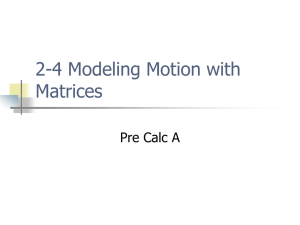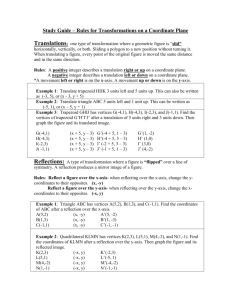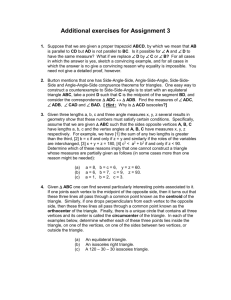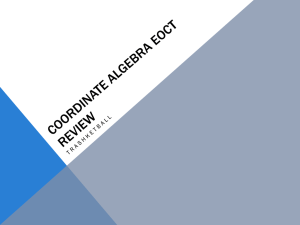CARTESIAN SYSTEM OF RECTANGULAR COORDINATES
advertisement
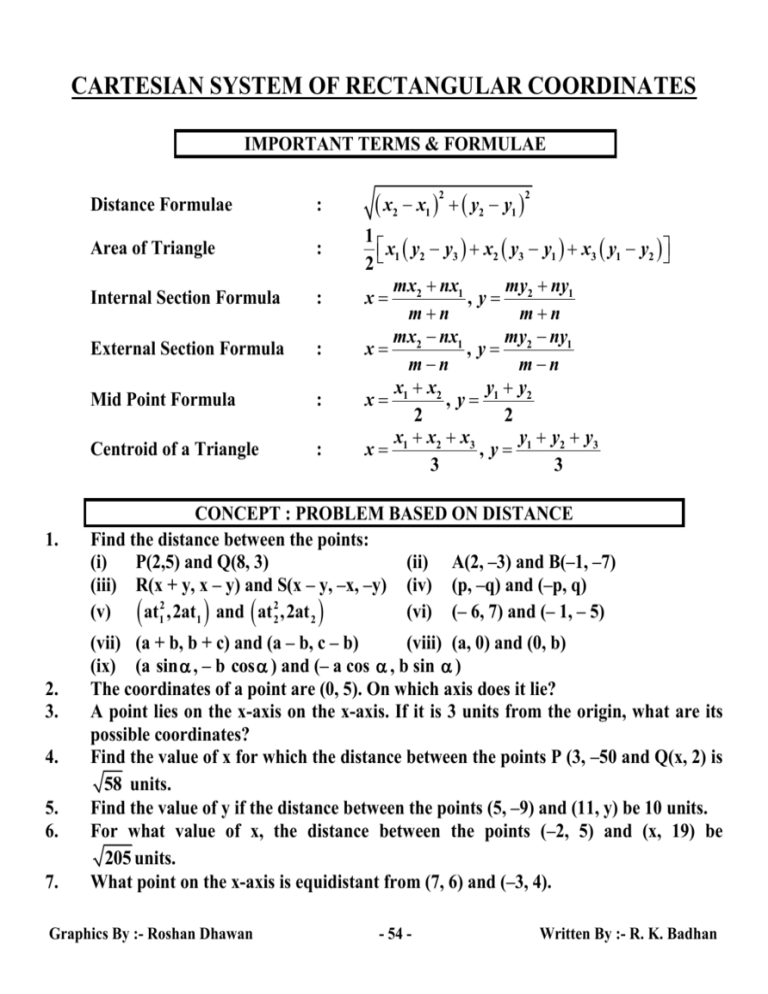
CARTESIAN SYSTEM OF RECTANGULAR COORDINATES IMPORTANT TERMS & FORMULAE 1. 2. 3. 4. 5. 6. 7. Distance Formulae : Area of Triangle : Internal Section Formula : External Section Formula : Mid Point Formula : Centroid of a Triangle : x2 x1 y2 y1 2 2 1 x1 y2 y3 x2 y3 y1 x3 y1 y2 2 mx2 nx1 my2 ny1 x , y mn mn mx2 nx1 my2 ny1 x , y mn mn x x2 y y2 x 1 , y 1 2 2 x x2 x3 y y2 y3 x 1 , y 1 3 3 CONCEPT : PROBLEM BASED ON DISTANCE Find the distance between the points: (i) P(2,5) and Q(8, 3) (ii) A(2, –3) and B(–1, –7) (iii) R(x + y, x – y) and S(x – y, –x, –y) (iv) (p, –q) and (–p, q) (v) at12 ,2at1 and at 22 ,2at 2 (vi) (– 6, 7) and (– 1, – 5) (vii) (a + b, b + c) and (a – b, c – b) (viii) (a, 0) and (0, b) (ix) (a sin , – b cos ) and (– a cos , b sin ) The coordinates of a point are (0, 5). On which axis does it lie? A point lies on the x-axis on the x-axis. If it is 3 units from the origin, what are its possible coordinates? Find the value of x for which the distance between the points P (3, –50 and Q(x, 2) is 58 units. Find the value of y if the distance between the points (5, –9) and (11, y) be 10 units. For what value of x, the distance between the points (–2, 5) and (x, 19) be 205 units. What point on the x-axis is equidistant from (7, 6) and (–3, 4). Graphics By :- Roshan Dhawan - 54 - Written By :- R. K. Badhan 8. 9. 10. 11. 12. 13. 14. 15. 16. 17. 18. 19. 20. 21. 22. 23. 24. 25. 26. 27. If the point (2, 1) and (1, –2) are equidistant from the point (x, y), show that x + 3y = 0. The length of a line segment is of 10 units and the coordinates of one end point are (2, –3). If the abscissa of the other end is 10, find the ordinate of the other end. Prove that (2, –2), (–2, 1) and (5, 2) are the vertices of a right angles triangle. Find the area of the triangle and length of the hypotenuse. Prove that the points (2a, 4a), (2a, 6a) and (2a + 3 a, 5a0) are the vertices of an equilateral triangle. Prove that the points (2, 3), (–4, –6) and (1, 3/2) do not form a triangle. An equilateral triangle has two vertices at the points (3, 4) and (–2, 3), find the coordinates of the third vertex. Two vertices of an isosceles triangle are (2, 0) and (2, 5). Find the vertex if the length of the equal sides is 3. Show that the points (0, 0), (0, 5), (6, 5), (6, 0) represent a rectangle. Show that the points (0, 5), (–2, –2), (5, 0), (7, 7) are the vertices of a rhombus. Prove that the points (5, 6), (1, 5), (2, 1) and (6, 2) are the vertices of a square. Using distance formula, show that (3, 3) is the center of the circle passing through the points (6, 2) (0, 4) and (4, 6). Find the radius of the circle. The opposite angular points of a square are (3, 4) and (1, –1). Find the coordinates of the remaining two vertices. Prove that the points P (3, 0), Q(6, 4), R(–1, 3) are the vertices of a right angles triangle. Are these vertices of an isosceles triangle also? Prove that the points (a, b + c), (b, c + a) and (c, a + b) are collinear. Two vertices of an equilateral triangle are (0, 0) and 0, 2 3 . Find the third vertex. CONCEPT : PROBLEMS BASED ON SECTION FORMULAE Find the coordinates of the point which divides internally the line segment joining (1, –3) and (–3, 9) in the ratio 1:3. Find the coordinates of the point which divides externally the line segment joining (2, –5) and (8, 1) in the ratio 2:5. Find the coordinates of the point which divides externally the line segment joining the points (5, –2) and (9, 6) in the ratio 3:1. Find the coordinates of the points of P and Q are (2, –1) and (–3, 4). What will be the value of y if the point (23/5, y) divides the line segment joining the points (5, 7) and (4, 5) in the ratio 2:3 internally. Graphics By :- Roshan Dhawan - 55 - Written By :- R. K. Badhan 28. 29. 30. 31. 32. 33. 34. 35. 36. 37. 38. 39. 40. 41. 42. 43. 44. 45. 46. Find the coordinates of the points of the trisection of the line segment joining the points (5, –3) and (2, –9). Find the coordinates of a point on the line joining the points A(5, –4) and B(–3, 2) that is, twice as far as from A as from B. Determine the ratio in which the point P(m, 6) divides the join of A(–4, 3) and B(2, 8). Also find the value of m. Find the coordinates of the center of a circle, the coordinates of the end points of a diameter being (–3, 8) and (5, 6). The mid point of a line segment is (–4, –2). If one end point is (–6, 4). What are the coordinates of the second end point? The line segment joining A (6, 3) to B (–1, –4) is doubled in length by having half its length added to each end. Find the coordinates of the new ends. If the vertices of a triangle are (–1, 5), (3, 1) and (5, 7). Find the length of the median through the third vertex. In what ratio does the point (1/2, 6) divide the line segment joining the points (3, 5) and (–7, 9). In what ratio is the line segment joining (–3, –1) and (–8, –9) divided at the point (– 5, –21/5). If the midpoint of the line joining (3, 4) and (k, 7) is (x, y) and 2x + 2y + 1 = 0. Find the value of k. Determine the ratio in which the straight line x – y – 2 = 0 divides the line segment joining (3, –1) and (8, 9). Find the ratio in which the line segment joining (–2, –3) and (5, 6) is divided by: a. x-axis b. y-axis If (2, 5), (3, 4) and (1, 3) are mid points of the sides of a triangle. Find the coordinates of the vertices. Find the ratio in which the line segment joining (2, –3) and (5, 6) is divided by xaxis. By using section formula, show that the points (5, 2), (–1, –1) and (1, 0) are collinear. CONCEPT : CENTROID, PARALLELOGRAM Find the coordinates of the point where the diagonals of the parallelogram formed by joining the points (–2, –1), (1, 0), (4, 3) and (1, 2) meet. Prove that the points (4, –11), (5, 3), (2, 15) and (1, 1) form a parallelogram. Show that the points (1, 1), (4, 4), (4, 8) and (1, 5) are the vertices of a parallelogram. The three vertices of a parallelogram are (3, 4), (3, 8), (9, 8). Find the fourth vertex. Graphics By :- Roshan Dhawan - 56 - Written By :- R. K. Badhan 47. 48. 49. 50. 51. 52. 53. Show that the point A(1, –2), B(3, 6), C(5, 10) and D(3, 2) are the vertices of a parallelogram. Three consecutive vertices of a parallelogram are (–2, –1), (1, 0) and (4, 3). Find the forth vertex. If the points (–2, –1), (1, 0), (x, 3) and (1, y) form a parallelogram, find the values of x and y. Find the centroid of a triangle whose vertices are x1 , y1 x2 , y2 and x3 , y3 . Also show that medians of this triangle are concurrent. Find the centroid of a triangle whose vertices are A(–1, 0), B(5, –2) and C(8, 2). Find the vertex of a triangle if two of its vertices are at (–1, 4) and (5, 2) and the centroid at (0, –3). A(3, 2) and B(–2, 1) are two vertices of a triangle ABC, whose centroid G has coordinates (5/3, –1/3). Find the coordinates of the third vertex C of the triangle. Graphics By :- Roshan Dhawan - 57 - Written By :- R. K. Badhan
